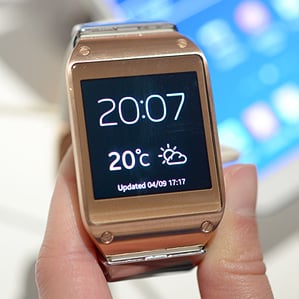Amazon Gate
- Back to Home »
- Is Samsung’s Galaxy Gear the First Truly Smart Watch?
Sunday, September 8, 2013
Is Samsung’s Galaxy Gear the First Truly Smart Watch?
Samsung’s new smart watch may be the most polished effort yet—but that doesn’t mean it’ll be a hit.
- By Tim Carmody/technologyreview.com on September 2013
At events held simultaneously in Berlin and New York, Samsung announced three new products, including a smart watch that marks the company’s first foray into wearable computing.
Along with the watch, called the Galaxy Gear, Samsung executives announced an oversized 5.5-inch smartphone (or “phablet”)—the Galaxy Note 3—and a tablet called the Galaxy Note 10.1. All three devices will be available in 149 countries beginning on September 25.
By far the most intriguing, and most highly anticipated, of the devices is the Galaxy Gear. JK Shin, head of Samsung Mobile, acknowledged as much when, moments into his presentation of the Note 3, a notification alarm went off. “I just got a message,” Shin said, as a graphic teasing the not-yet-shown watch appeared behind him. (“Don’t forget to mention Android,” read the message on the Gear’s mocked-up notification screen.)
The Galaxy Gear is a full-color Android-based device about the size of an old calculator watch. It runs its own applications and was shown running apps developed by both Samsung and third-party partners. It can take photographs through a camera mounted on the wristband, facing away from the wearer, and has a pedometer that can track the wearer’s activity.
The Gear is meant to be paired with other Samsung Galaxy devices, whether phones, Notes, or tablets. One way to think about it is as the equivalent of a Bluetooth headset, but for people who communicate largely through text and images. As an alternative user interface for its paired phone or tablet, it delivers notifications, from text messages to news alerts; it can even dial phone numbers and place calls, but only when paired with a phone or tablet hooked up to a wireless phone network. The microphone for phone calls can also be used for voice memos, although there’s a five-minute limit on what can be recorded in a single go.
On stage in Berlin, Samsung director of research Pranav Mistry—a recent addition to Samsung’s in-house Think Tank, who is probably best known for the SixthSense interface he developed as a graduate researcher at MIT’s Media Lab—said that wearable devices are “not just about giving a new [name] or a new form to devices, but about creating new experiences.”
Over in New York, Samsung’s chief product officer, Kevin Packingham, was more matter-of-fact. He told me that for Samsung wearables are about a return to simplicity, which meant carefully editing the watch’s functions down rather than trying to pack in too much at once.
After the presentations, reporters and photographers were given hands-on access to the new Galaxy Gear and Note devices. The Gear, available with wristbands of six different colors and materials, has a 1.63-inch (or 41.4-millimeter) Super AMOLED display, with a 320-by-320 pixel resolution. For comparison, the sixth-generation square iPod Nano, which had a similar color touch screen, had a 1.5-inch display with 240-by-240 resolution. The Gear has an 800-megahertz processor, 512 megabytes of RAM, and four gigabytes of onboard storage. The first iPhone had four gigabytes of storage, 128 megabytes of RAM, and a 620-megahertz processor.
All that power, plus the sensors and Bluetooth, comes at a cost. The device is expected to cost $299 and has a 315-milliamp-hour lithium-ion battery, which Samsung says lasts about a day. The watch clips into a dock, which then charges using a standard micro-USB cord. None of Samsung’s official materials said whether a day meant 12, 18, or 24 hours, and none of the representatives I asked could clarify.
The body of the Galaxy Gear is stainless steel, and at about 74 grams, it’s fairly heavy. (Conventional metal wristwatches can run up to 100 grams before weight really becomes a problem, but this weight is usually distributed over the entire watch, which makes it feel more balanced.) There’s a sleep/wake button on the right-hand side, and the watch powers itself down quite quickly.
The wristband on our demo device adjusted to four different lengths, with a bracelet-style metal clasp that snaps shut. Ahead of me, a woman with relatively small wrists found the Gear sliding down with the band at the smallest setting. My arms and wrists are fairly large, and I couldn’t get the same watch to close at all. A Samsung representative assured me that the bands available at launch would be more adjustable.

It’s possible to interact with the Gear using simple gestures: a swipe upward activates the camera, while a swipe down brings up the home screen showing time, weather, and news headlines. A swipe to the right or left lets you scroll through contacts, logs, apps, settings, the pedometer, music, a gallery, voice memos, and notifications. It’s simple and largely works very well.
The third-party applications available at launch include information management tools like Pocket and Evernote, fitness apps like RunKeeper, and more esoteric options like Vivino Wine Scanner, which allows users to take a picture of a bottle of wine and learn more about it. The set of partners is currently limited, but Packingham told me he expects that a software development kit will be released once the kinks with the device’s current API are worked out.Samsung and other companies trying to create a market for smart watches are betting that these devices can become an attractive new platform for application development. It’s not yet clear how well that model will succeed, and who will control the market. But at least the Galaxy Gear gives us a new way to examine those questions.














Post a Comment